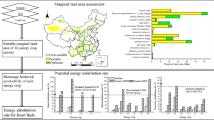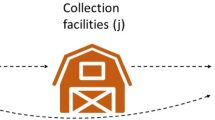Abstract
Biomass is an important energy source that has the ability to reduce dependencies on fossil fuels, while providing a greener source of energy and helping achieve sustainability. Among the most commonly used biomass feedstock is corn stover, corn residue remaining in the fields after harvesting. One of the biggest challenges of using corn stover as biomass feedstock is that burning it in field is the fastest and cheapest way for many growers so as to remove it and grow new crops. This leftover corn stover could be, instead, converted to bioethanol. In this work, we propose a decision support system for expanding existing biorefineries or building new ones to help stakeholders design a supply chain network model that converts all of the available corn stover to bioethanol. Two configurations presented in this study which is the existing plant expansion (EP) configuration and the combination of existing and new plant configuration (ENP), by exploring the incentive and greenhouse gas (GHG) emission price value for the bioenergy plant to achieve the goal. The aim of converting all corn stover is successfully achieved along with the other goals of achieving sustainability by reducing the amount of GHG emissions in the supply chain. Our results reveal that we can achieve a minimum amount of GHG emissions, while maximizing profit from the supply chain, when expanding existing plants and building new plants (ENP configuration) leading to a reduction of GHG emissions by 4%.



















Similar content being viewed by others
References
Ghatak, H.R.: Biorefineries from the perspective of sustainability: feedstocks, products, and processes. Renew. Sustain. Energy Rev. 15, 4042–4052 (2011). https://doi.org/10.1016/j.rser.2011.07.034
U.S. Energy Information Administration.: Biomass—energy explained, your guide to understanding energy. Energy Information Administration (2017). https://www.eia.gov/energyexplained/?page=biomass_home#tab1
Perlack, R.D., Wright, L.L., Turhollow, A.F., Graham, R.L., Stokes, B.J., Erbach, D.C.: Biomass as feedstock for a bioenergy and bioproducts industry: the technical feasibility of a billion-ton annual supply (2005). https://www1.eere.energy.gov/bioenergy/pdfs/final_billionton_vision_report2.pdf
Sharma, B., Ingalls, R.G., Jones, C.L., Khanchi, A.: Biomass supply chain design and analysis: basis, overview, modeling, challenges, and future. Renew. Sustain. Energy Rev. 24, 608–627 (2013). https://doi.org/10.1016/j.rser.2013.03.049
Young, J.D., Anderson, N.M., Naughton, H.T., Mullan, K.: Economic and policy factors driving adoption of institutional woody biomass heating systems in the U.S. Energy Econ. 69, 456–470 (2018). https://doi.org/10.1016/j.eneco.2017.11.020
Mohamed Abdul Ghani, N.M.A., Egilmez, G., Kucukvar, M., S. Bhutta, M.K.: From green buildings to green supply chains. Manag. Environ. Qual. 28, 532–548 (2017). https://doi.org/10.1108/meq-12-2015-0211
Shafiee, S., Topal, E.: When will fossil fuel reserves be diminished? Energy Policy 37, 181–189 (2009). https://doi.org/10.1016/j.enpol.2008.08.016
Raftery, J.P., Karim, M.N.: Economic viability of consolidated bioprocessing utilizing multiple biomass substrates for commercial-scale cellulosic bioethanol production. Biomass Bioenergy 103, 35–46 (2017). https://doi.org/10.1016/j.biombioe.2017.05.012
Lainez-Aguirre, J.M., Pérez-Fortes, M., Puigjaner, L.: Economic evaluation of bio-based supply chains with CO2 capture and utilisation. Comput. Chem. Eng. 102, 213–225 (2017). https://doi.org/10.1016/j.compchemeng.2016.09.007
Akgul, O., Shah, N., Papageorgiou, L.G.: Economic optimisation of a UK advanced biofuel supply chain. Biomass Bioenergy 41, 57–72 (2012). https://doi.org/10.1016/j.biombioe.2012.01.040
Kim, S., Dale, B.E.: Comparing alternative cellulosic biomass biorefining systems: centralized versus distributed processing systems. Biomass Bioenergy 74, 135–147 (2015). https://doi.org/10.1016/j.biombioe.2015.01.018
Wang, Y., Ebadian, M., Sokhansanj, S., Webb, E., Lau, A.: Impact of the biorefinery size on the logistics of corn stover supply—a scenario analysis. Appl. Energy 198, 360–376 (2017). https://doi.org/10.1016/j.apenergy.2017.03.056
Clauser, N.M., Gutiérrez, S., Area, M.C., Felissia, F.E., Vallejos, M.E.: Small-sized biorefineries as strategy to add value to sugarcane bagasse. Chem. Eng. Res. Des. 107, 137–146 (2016). https://doi.org/10.1016/j.cherd.2015.10.050
Gonzales, D.S., Searcy, S.W.: GIS-based allocation of herbaceous biomass in biorefineries and depots. Biomass Bioenergy 97, 1–10 (2017). https://doi.org/10.1016/j.biombioe.2016.12.009
Sahoo, K., Hawkins, G.L., Yao, X.A., Samples, K., Mani, S.: GIS-based biomass assessment and supply logistics system for a sustainable biorefinery: a case study with cotton stalks in the Southeastern US. Appl. Energy 182, 260–273 (2016). https://doi.org/10.1016/j.apenergy.2016.08.114
Zhang, F., Wang, J., Liu, S., Zhang, S., Sutherland, J.W.: Integrating GIS with optimization method for a biofuel feedstock supply chain. Biomass Bioenergy 98, 194–205 (2017). https://doi.org/10.1016/j.biombioe.2017.01.004
Craige, C.C., Buser, M.D., Frazier, R.S., Hiziroglu, S.S., Holcomb, R.B., Huhnke, R.L.: Conceptual design of a biofeedstock supply chain model for eastern redcedar. Comput. Electron. Agric. 121, 12–24 (2016). https://doi.org/10.1016/j.compag.2015.11.019
De Meyer, A., Cattrysse, D., Van Orshoven, J.: Considering biomass growth and regeneration in the optimisation of biomass supply chains. Renew. Energy 87, 990–1002 (2016). https://doi.org/10.1016/j.renene.2015.07.043
Bai, Y., Hwang, T., Kang, S., Ouyang, Y.: Biofuel refinery location and supply chain planning under traffic congestion. Transp. Res. Part B Methodol. 45, 162–175 (2011). https://doi.org/10.1016/j.trb.2010.04.006
Parker, N., Tittmann, P., Hart, Q., Nelson, R., Skog, K., Schmidt, A., Gray, E., Jenkins, B.: Development of a biorefinery optimized biofuel supply curve for the Western United States. Biomass Bioenergy 34, 1597–1607 (2010). https://doi.org/10.1016/j.biombioe.2010.06.007
Li, Y., Hu, G., Wright, M.M.: An optimization model for sequential fast pyrolysis facility location-allocation under renewable fuel standard. Energy 93, 1165–1172 (2015). https://doi.org/10.1016/j.energy.2015.09.090
Huang, Y., Chen, Y.: Analysis of an imperfectly competitive cellulosic biofuel supply chain. Transp. Res. Part E Logist. Transp. Rev. 72, 1–14 (2014). https://doi.org/10.1016/j.tre.2014.09.008
Ng, R.T.L., Maravelias, C.T.: Economic and energetic analysis of biofuel supply chains. Appl. Energy 205, 1571–1582 (2017). https://doi.org/10.1016/j.apenergy.2017.08.161
Hu, C., Liu, X., Lu, J.: A bi-objective two-stage robust location model for waste-to-energy facilities under uncertainty. Decis. Support Syst. 99, 37–50 (2017). https://doi.org/10.1016/j.dss.2017.05.009
Lauven, L.P.: An optimization approach to biorefinery setup planning. Biomass Bioenergy 70, 440–451 (2014). https://doi.org/10.1016/j.biombioe.2014.07.026
Ekşioğlu, S.D., Acharya, A., Leightley, L.E., Arora, S.: Analyzing the design and management of biomass-to-biorefinery supply chain. Comput. Ind. Eng. 57, 1342–1352 (2009). https://doi.org/10.1016/j.cie.2009.07.003
Rentizelas, A.A., Tatsiopoulos, I.P.: Locating a bioenergy facility using a hybrid optimization method. Int. J. Prod. Econ. 123, 196–209 (2010). https://doi.org/10.1016/j.ijpe.2009.08.013
Ghafghazi, S., Sowlati, T., Sokhansanj, S., Bi, X., Melin, S.: Life cycle assessment of base–load heat sources for district heating system options. Int. J. Life Cycle Assess. 16, 212–223 (2011). https://doi.org/10.1007/s11367-011-0259-9
Ebadian, M., Sowlati, T., Sokhansanj, S., Townley-Smith, L., Stumborg, M.: Modeling and analysing storage systems in agricultural biomass supply chain for cellulosic ethanol production. Appl. Energy 102, 840–849 (2013). https://doi.org/10.1016/j.apenergy.2012.08.049
Chang, K.H.: A decision support system for planning and coordination of hybrid renewable energy systems. Decis. Support Syst. 64, 4–13 (2014). https://doi.org/10.1016/j.dss.2014.04.001
Mattiussi, A., Rosano, M., Simeoni, P.: A decision support system for sustainable energy supply combining multi-objective and multi-attribute analysis: an Australian case study. Decis. Support Syst. 57, 150–159 (2014). https://doi.org/10.1016/j.dss.2013.08.013
Hunt, J.D., Bañares-Alcántara, R., Hanbury, D.: A new integrated tool for complex decision making: application to the UK energy sector. Decis. Support Syst. 54, 1427–1441 (2013). https://doi.org/10.1016/j.dss.2012.12.010
Kurkalova, L.A., Carter, L.: Sustainable production: using simulation modeling to identify the benefits of green information systems. Decis. Support Syst. 96, 83–91 (2017). https://doi.org/10.1016/j.dss.2017.02.006
Hakanen, J., Miettinen, K., Sahlstedt, K.: Wastewater treatment: new insight provided by interactive multiobjective optimization. Decis. Support Syst. 51, 328–337 (2011). https://doi.org/10.1016/j.dss.2010.11.026
Macharis, C., Turcksin, L., Lebeau, K.: Multi actor multi criteria analysis (MAMCA) as a tool to support sustainable decisions: state of use. Decis. Support Syst. 54, 610–620 (2012). https://doi.org/10.1016/j.dss.2012.08.008
Rosaly, B., Laurèn, D.: Renewable Energy 101 and the Importance of Incentives_The Sustainability Co-Op (2013). https://thesustainabilitycooperative.net/2013/10/13/all-about-renewables/
Bangalore, M., Hochman, G., Zilberman, D.: Policy incentives and adoption of agricultural anaerobic digestion: a survey of Europe and the United States. Renew. Energy 97, 559–571 (2016). https://doi.org/10.1016/j.renene.2016.05.062
Simsek, H.A., Simsek, N.: Recent incentives for renewable energy in turkey. Energy Policy 63, 521–530 (2013). https://doi.org/10.1016/j.enpol.2013.08.036
Tongsopit, S., Greacen, C.: An assessment of Thailand’s feed-in tariff program. Renew. Energy 60, 439–445 (2013). https://doi.org/10.1016/j.renene.2013.05.036
Supriyasilp, T., Pinitjitsamut, M., Pongput, K., Wanaset, A., Boonyanupong, S., Rakthai, S., Boonyasirikul, T.: A challenge of incentive for small hydropower commercial investment in Thailand. Renew. Energy 111, 861–869 (2017). https://doi.org/10.1016/j.renene.2017.05.009
Ozcan, M.: Assessment of renewable energy incentive system from investors’ perspective. Renew. Energy 71, 425–432 (2014). https://doi.org/10.1016/j.renene.2014.05.053
Cobuloglu, H.I., Büyüktahtakın, İ.E.: A mixed-integer optimization model for the economic and environmental analysis of biomass production. Biomass Bioenergy 67, 8–23 (2014). https://doi.org/10.1016/j.biombioe.2014.03.025
Fattahi, M., Govindan, K.: A multi-stage stochastic program for the sustainable design of biofuel supply chain networks under biomass supply uncertainty and disruption risk: a real-life case study. Transp. Res. Part E Logist. Transp. Rev. (2018). https://doi.org/10.1016/j.tre.2018.08.008
Asadi, E., Habibi, F., Nickel, S., Sahebi, H.: A bi-objective stochastic location-inventory-routing model for microalgae-based biofuel supply chain. Appl. Energy (2018). https://doi.org/10.1016/j.apenergy.2018.07.067
Xie, F., Huang, Y.: A multistage stochastic programming model for a multi-period strategic expansion of biofuel supply chain under evolving uncertainties. Transp. Res. Part E Logist. Transp. Rev. (2018). https://doi.org/10.1016/j.tre.2018.01.015
Liu, Z., Johnson, T.G., Altman, I.: The moderating role of biomass availability in biopower co-firing—a sensitivity analysis. J. Clean. Prod. 135, 523–532 (2016). https://doi.org/10.1016/j.jclepro.2016.06.101
Mohamed Abdul Ghani, N.M.A., Vogiatzis, C., Szmerekovsky, J.: Biomass feedstock supply chain network design with biomass conversion incentives. Energy Policy 116, 39–49 (2018). https://doi.org/10.1016/j.enpol.2018.01.042
Henke, J., ISCC.: Low Carbon Fuel Regulation in North America and the EU (2018). https://www.iscc-system.org/wp-content/uploads/2017/02/4.-Henke_Low-Carbon-Fuel-Regulation-in-North-America-and-the-EU_ISCCConference-Bogota%CC%81-2018.pdf
USDA.: Corn 57 (2016). https://www.usda.gov/nass/PUBS/TODAYRPT/acrg0616.pdf
Mayer, M.: Placing a Value on Corn Stover. UW Ext. 2012 (2012). https://green.extension.wisc.edu/files/2010/05/Placing-a-Value-on-Corn-Stover.pdf
Maung, T.A., Gustafson, C.R.: The viability of harvesting corn cobs and stover for biofuel production in North Dakota (2011). https://ideas.repec.org/p/ags/aaea11/103613.html
Tao, L., Templeton, D.W., Humbird, D., Aden, A.: Bioresource technology effect of corn stover compositional variability on minimum ethanol selling price (MESP). Bioresour. Technol. 140, 426–430 (2013). https://doi.org/10.1016/j.biortech.2013.04.083
Gallagher, P.W.: Biomass supply from corn residues: estimates and critical review of procedures (2012). https://www.usda.gov/oce/reports/energy/Biomass%20Supply%20From%20Corn%20Residues-Nov-2012.pdf
Gustafson, C.R., Maung, T.A., Saxowsky, D.: Economics of sourcing cellulosic feedstock for energy production (2011). https://ideas.repec.org/p/ags/aaea11/103260.html
Xie, F., Huang, Y., Eksioglu, S.: Bioresource technology integrating multimodal transport into cellulosic biofuel supply chain design under feedstock seasonality with a case study based on California. Bioresour. Technol. 152, 15–23 (2014). https://doi.org/10.1016/j.biortech.2013.10.074
Humbird, D., Davis, R., Tao, L., Kinchin, C., Hsu, D., Aden, A., Schoen, P., Lukas, J., Olthof, B., Worley, M., Sexton, D.: Process design and economics for biochemical conversion of lignocellulosic biomass to ethanol (2011). https://www.osti.gov/biblio/1013269-process-design-economics-biochemicalconversion-lignocellulosic-biomass-ethanol-dilute-acid-pretreatment-enzymatichydrolysis-corn-stover
Aakre, D.G., Haugen, R.: Results of the North Dakota land valuation model for the 2013 agricultural real estate assessment, p. 21 (2013). https://ideas.repec.org/p/ags/nddaae/157657.html
Mcaloon, A., Taylor, F., Yee, W., Regional, E., Ibsen, K., Wooley, R., Biotechnology, N.: Determining the cost of producing ethanol from corn starch and lignocellulosic feedstocks (2000). https://www.nrel.gov/docs/fy01osti/28893.pdf
ESRI.com.: ESRI (2016). https://www.esri.com/en-us/home
Osmani, A., Zhang, J.: Multi-period stochastic optimization of a sustainable multi-feedstock second generation bioethanol supply chain—a logistic case study in Midwestern United States. Land Use Policy 61, 420–450 (2017). https://doi.org/10.1016/j.landusepol.2016.10.028
OpenSolver.: OpenSolver for Excel—The Open Source Optimization Solver for Excel. https://opensolver.org/
Brechbill, S., Tyner, W.E.: The economics of renewable energy: corn stover and switchgrass. Perdue Ext. Publ., pp 1–6. (2008). https://www.extension.purdue.edu/extmedia/ID/ID-404.pdf
James, D.S.: The viability of lignocellulosic ethanol production as a business endeavour in Canada (2013). https://open.library.ubc.ca/cIRcle/collections/ubctheses/24/items/1.0073518
Acknowledgements
Part of this work was performed while Dr. Chrysafis Vogiatzis was an Assistant Professor with the Department of Industrial and Manufacturing Engineering at North Dakota State University. Funding: Chrysafis Vogiatzis would like to acknowledge support by Grant ND EPSCoR NSF 1355466.
Author information
Authors and Affiliations
Corresponding author
Additional information
Publisher's Note
Springer Nature remains neutral with regard to jurisdictional claims in published maps and institutional affiliations.
Rights and permissions
About this article
Cite this article
Mohamed Abdul Ghani, N.M.A., Szmerekovsky, J.G. & Vogiatzis, C. Plant capacity level and location as a mechanism for sustainability in biomass supply chain. Energy Syst 11, 1075–1109 (2020). https://doi.org/10.1007/s12667-019-00361-z
Received:
Accepted:
Published:
Issue Date:
DOI: https://doi.org/10.1007/s12667-019-00361-z




